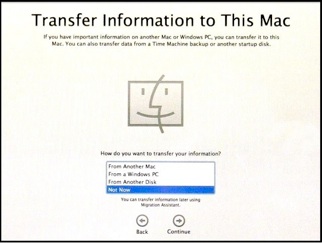Time Machine - Frequently Asked Questions
19. I got a new Mac, or a new or erased internal HD -- now what?
Time Machine - Frequently Asked Questions
19. I got a new Mac, or a new or erased internal HD -- now what?
A New Mac:
You can set up your shiny new Mac just like the old one, either directly from the old Mac, or from its Time Machine or "clone" backups.
It's best by far to do that when the new Mac first starts up. If you wait (to experiment with it first), you can still do it, but it's much harder to do without encountering some problems.

As noted there, if you transfer Computer Settings along with your other stuff, when you start the first Time Machine backup of the new Mac to the old Mac's backups, you should be asked if you want the new Mac to "inherit" the old Mac's backups (ie, treat them as if they were made from the new Mac). See Troubleshooting item #B5 for details.
If you elect to inherit the backups, the next backup will take somewhat longer than usual in the Preparing and Copying phases, but will only do a relatively small backup, of things changed since the backup you restored.
If you didn't get the prompt, or wish to change your mind, you may be able to cancel the backup and manually tell Time Machine to inherit the backups and "associate" the new drive with the old backups via the procedures in Troubleshooting item #B6.
Until the old backups are "inherited," however, they won't appear when you Enter Time Machine from the new Mac. You can use the Browse Other Backup Disks option to see them, per the green box in FAQ #17.
If you've already skipped Setup Assistant (selected Not Now, set up a user account, etc.), and used the Migration Assistant app later on, or done something else, see Problems After Using Migration Assistant for some explanations and possible workarounds.
A New or erased internal HD:
•The best option is to restore your entire system from your Time Machine backups, (although if you have "clone" backups, you can "re-clone" from them to your internal HD). Even if Apple or the repair shop installed OSX, this is usually best -- they may not have installed the correct version of OSX to work with your other apps, and if they also set up a test user account (to be sure everything works), that can cause problems.
Start from your Recovery HD (or OSX Install Disc on Snow Leopard or earlier) to do the full system restore. See Time Machine FAQ #14 for detailed instructions. Note that if you replaced/erased your HD because of system or hardware problems, those problems may have been backed-up, so you might want to select an earlier backup, not the most recent one, so you don't bring the problem back.
•An alternative is to install OSX, then use Setup Assistant to transfer your stuff when your Mac restarts. See Using Setup Assistant on Mountain Lion or Lion or Using Setup Assistant on Snow Leopard or Leopard (they've very similar, but with some differences). Be sure to let it transfer Computer Settings.
•If you've already done something else, consider starting over, per one of the workarounds in the green box in Problems after using Migration Assistant.
•After the restore or transfer, when you start the next backup to the old Mac's backups, Time Machine will take somewhat longer than usual in the Preparing and copying phases, but should only do a relatively small backup, of things changed since the backup you selected above. If it does start a full backup, cancel it immediately. You may be able to manually tell Time Machine to "associate" the new or erased drive with the old backups via the procedure in Troubleshooting item #B6.
Until you run that backup or do the "associate" manually, however, when you Enter Time Machine the backups won't appear normally -- they're treated as being from a different disk, that's no longer available. You can see them via the procedure in Troubleshooting item #E3.